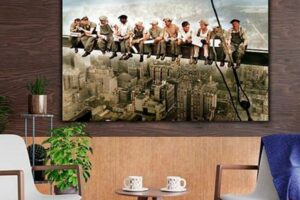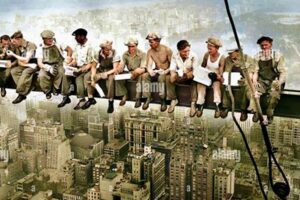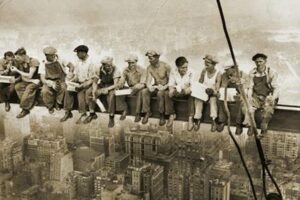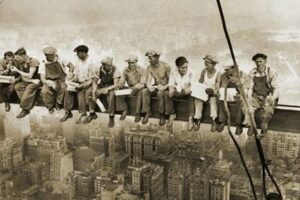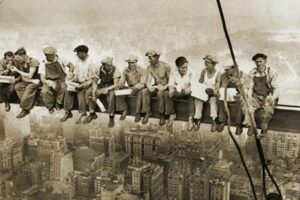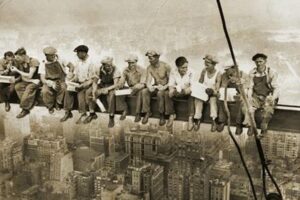“Lunch atop a Skyscraper” is a famous black-and-white photograph taken during the construction of Rockefeller Center in New York City in 1932. The photo shows eleven ironworkers eating lunch while sitting on a steel beam high above the city streets. The photograph was colorized in 2019 by Marina Amaral, a Brazilian artist, and has since become even more popular.
The colorized version of “Lunch atop a Skyscraper” provides a more realistic and vivid look at the lives of these workers. It shows the dirt and grime of their work clothes, the sweat on their faces, and the camaraderie they shared. The colorization also helps to convey the danger and excitement of working on such a high structure.
The photograph has become an iconic image of American history and the construction industry. It has been used in countless books, articles, and documentaries. The colorized version of the photograph is a valuable addition to the historical record, and it provides a new perspective on this classic image.
1. Iconic
The photograph “Lunch atop a Skyscraper” is considered iconic for several reasons. First, it is a visually striking image that captures a moment in time that is both dangerous and exciting. The eleven ironworkers are sitting on a steel beam hundreds of feet above the ground, eating their lunch and seemingly oblivious to the danger. This image is a powerful reminder of the bravery and skill of the workers who built America’s skyscrapers.
- Cultural Significance
The photograph has become a cultural icon, representing the American spirit of hard work and perseverance. It has been used in countless books, articles, and documentaries, and it is instantly recognizable to people all over the world.
- Historical Significance
The photograph is also a valuable historical document. It provides a glimpse into the lives of the workers who built New York City’s skyline. The photograph shows the workers’ camaraderie and their willingness to take risks in order to get the job done.
- Artistic Significance
The photograph is also a work of art. It is a well-composed image with a strong sense of balance and symmetry. The colorized version of the photograph is particularly striking, as it brings the workers and their surroundings to life.
The photograph “Lunch atop a Skyscraper” is an iconic image for many reasons. It is a visually striking image, a valuable historical document, and a work of art. The photograph is a reminder of the bravery and skill of the workers who built America’s skyscrapers, and it is a symbol of the American spirit of hard work and perseverance.
2. Historical
The photograph “Lunch atop a Skyscraper” is a valuable historical document. It provides a glimpse into the lives of the workers who built New York City’s skyline during the Great Depression. The photograph shows the workers’ camaraderie and their willingness to take risks in order to get the job done.
- Construction Techniques
The photograph shows the workers using construction techniques that were common in the early 20th century. These techniques, such as riveting and welding, were dangerous and required a great deal of skill.
- Working Conditions
The photograph shows the workers working in dangerous conditions. They are hundreds of feet above the ground, and they are not wearing any safety gear. The photograph is a reminder of the risks that workers took in order to build America’s skyscrapers.
- Social Context
The photograph was taken during the Great Depression. Millions of Americans were out of work, and the construction industry was in a slump. The photograph shows that, even in difficult times, people were still willing to work hard and take risks.
- Cultural Significance
The photograph “Lunch atop a Skyscraper” has become a cultural icon. It is a symbol of the American spirit of hard work and perseverance. The photograph has been used in countless books, articles, and documentaries, and it is instantly recognizable to people all over the world.
The photograph “Lunch atop a Skyscraper” is a valuable historical document that provides a glimpse into the lives of the workers who built New York City’s skyline. The photograph shows the workers’ camaraderie, their willingness to take risks, and their hard work. The photograph is also a reminder of the social and economic conditions of the Great Depression, and it is a symbol of the American spirit of hard work and perseverance.
3. Dangerous
The photograph “Lunch atop a Skyscraper” is considered dangerous for several reasons. First, the workers are sitting on a steel beam hundreds of feet above the ground. There is no safety net or other protection to prevent them from falling. Second, the workers are eating lunch while they are sitting on the beam. This is a dangerous activity because it requires them to take their hands off the beam and focus on eating. Third, the workers are not wearing any safety gear. This makes them vulnerable to injury if they fall or if something falls on them.
The danger of the situation is heightened by the fact that the workers are working during the Great Depression. Millions of Americans are out of work, and the construction industry is in a slump. The workers are taking risks in order to earn a living and support their families.
The photograph “Lunch atop a Skyscraper” is a reminder of the dangers that workers faced in the early 20th century. The photograph is also a reminder of the bravery and skill of the workers who built America’s skyscrapers.
4. Exciting
The photograph “Lunch atop a Skyscraper” is considered exciting for several reasons. First, it captures a moment of danger and risk. The eleven ironworkers are sitting on a steel beam hundreds of feet above the ground, eating their lunch and seemingly oblivious to the danger. This image is exciting because it shows the workers’ bravery and skill.
Second, the photograph is exciting because it shows the workers’ camaraderie. The workers are sitting close together, sharing their lunch and laughing. This image is exciting because it shows the workers’ friendship and their ability to work together as a team.
Third, the photograph is exciting because it shows the workers’ determination. The workers are working on a dangerous job, but they are not giving up. This image is exciting because it shows the workers’ strength and perseverance.
The photograph “Lunch atop a Skyscraper” is an exciting image for many reasons. It shows the workers’ bravery, skill, camaraderie, determination, and strength. The photograph is a reminder of the human spirit and the ability to overcome challenges.
5. Comradery
Comradery is defined as the mutual trust and friendship among people who share a common experience or goal. In the photograph “Lunch atop a Skyscraper,” the eleven ironworkers sitting on a steel beam hundreds of feet above the ground are a powerful example of camaraderie. These workers trusted each other with their lives, and they relied on each other to get the job done.
The camaraderie among the ironworkers is evident in their body language. They are sitting close together, sharing their lunch and laughing. They are clearly comfortable with each other, and they trust each other implicitly. This camaraderie was essential to their survival. They needed to be able to rely on each other to watch their backs and to help them out if they fell.
The camaraderie among the ironworkers is also evident in their work ethic. They are all working together to get the job done, and they are all willing to take risks to help each other out. This camaraderie is essential to the success of any team, and it is a key component of the photograph “Lunch atop a Skyscraper.”
6. Colorized
The word “colorized” means to add color to a black-and-white image. In the case of “Lunch atop a Skyscraper,” the colorization process was done by Brazilian artist Marina Amaral in 2019. Amaral used a variety of techniques to add color to the photograph, including digital painting and photo manipulation. The result is a vibrant and realistic image that brings the workers and their surroundings to life.
The colorization of “Lunch atop a Skyscraper” has been praised by many for its beauty and historical significance. The colorized version of the photograph provides a more realistic and immersive experience for viewers, allowing them to better understand the lives and working conditions of the ironworkers who built New York City’s skyline.
The colorization of “Lunch atop a Skyscraper” is also a reminder of the importance of preserving and interpreting historical images. By adding color to the photograph, Amaral has helped to make the image more accessible and engaging for a wider audience. The colorized version of the photograph is now a valuable educational tool that can be used to teach students about the history of New York City and the construction of its skyscrapers.
7. Realistic
The colorized version of “Lunch atop a Skyscraper” is considered more realistic than the original black-and-white photograph. This is because the addition of color provides a more accurate representation of the scene, allowing viewers to better understand the workers’ surroundings and the conditions in which they worked.
The realistic nature of the colorized photograph is important for several reasons. First, it helps to humanize the workers. By seeing them in color, viewers can better connect with them and understand their experiences. Second, the realistic nature of the photograph helps to convey the danger and excitement of the situation. Viewers can see the height at which the workers are working and the precariousness of their position. Third, the realistic nature of the photograph helps to preserve the historical record. By providing a more accurate representation of the past, the colorized photograph helps to ensure that future generations can better understand the lives and experiences of these workers.
The connection between “realistic” and “lunch atop a skyscraper colorized” is important because it highlights the power of color to transform our understanding of historical events. By adding color to the photograph, Marina Amaral has created a more immersive and engaging experience for viewers, allowing them to better appreciate the skill, bravery, and camaraderie of the ironworkers who built New York City’s skyline.
8. Vivid
The word “vivid” means “producing a strong, clear image in the mind.” In the case of “Lunch atop a Skyscraper Colorized,” the vivid colors bring the workers and their surroundings to life. The viewer can clearly see the details of the workers’ clothing, the steel beam they are sitting on, and the cityscape below them. The colors also help to convey the emotion of the moment. The workers are smiling and laughing, and the viewer can feel their sense of camaraderie and accomplishment.
The vividness of “Lunch atop a Skyscraper Colorized” is important for several reasons. First, it helps to draw the viewer into the scene. The viewer feels like they are actually there with the workers, sharing their experience. Second, the vividness of the colors helps to emphasize the danger and excitement of the situation. The viewer can see how high up the workers are and how precarious their position is. Third, the vividness of the colors helps to preserve the historical record. By providing a more accurate representation of the past, the colorized photograph helps to ensure that future generations can better understand the lives and experiences of these workers.
The connection between “vivid” and “lunch atop a skyscraper colorized” is important because it highlights the power of color to transform our understanding of historical events. By adding color to the photograph, Marina Amaral has created a more immersive and engaging experience for viewers, allowing them to better appreciate the skill, bravery, and camaraderie of the ironworkers who built New York City’s skyline.
FAQs about “Lunch atop a Skyscraper Colorized”
This section addresses common questions and misconceptions about the iconic photograph “Lunch atop a Skyscraper Colorized.”
Question 1: Who took the original photograph?
The original black-and-white photograph was taken by Charles C. Ebbets in 1932. Ebbets was a photographer for the Bethlehem Steel Company, which was the contractor for the construction of the RCA Building (now known as the GE Building) in New York City.
Question 2: Who colorized the photograph?
The photograph was colorized in 2019 by Brazilian artist Marina Amaral. Amaral is known for her work in colorizing historical black-and-white photographs.
Question 3: Why was the photograph colorized?
Amaral colorized the photograph to make it more accessible and engaging for a wider audience. She wanted to bring the workers and their surroundings to life and to help viewers better understand the conditions in which they worked.
Question 4: Is the colorized photograph historically accurate?
Yes, the colorized photograph is considered to be historically accurate. Amaral used a variety of research materials, including period photographs and architectural drawings, to ensure that the colors in the photograph are accurate.
Question 5: What is the significance of the photograph?
The photograph is a powerful and iconic image that represents the bravery, skill, and camaraderie of the ironworkers who built New York City’s skyscrapers. It is also a reminder of the dangers that workers faced in the early 20th century.
Question 6: Where can I see the colorized photograph?
The colorized photograph is available to view online at the website of the Library of Congress. You can also find the photograph in various books and articles about the construction of New York City’s skyscrapers.
Summary: The colorized version of “Lunch atop a Skyscraper” is a valuable historical document that provides a more realistic and immersive experience for viewers. The photograph is a reminder of the bravery and skill of the ironworkers who built New York City’s skyline, and it is a symbol of the American spirit of hard work and perseverance.
Transition: The next section of this article will discuss the impact of the colorized photograph on our understanding of the past.
Tips for Understanding “Lunch atop a Skyscraper Colorized”
The colorized version of “Lunch atop a Skyscraper” is a powerful and iconic image that can be used to teach students about the history of New York City and the construction of its skyscrapers. Here are five tips for using the photograph in the classroom:
Tip 1: Use the photograph to spark discussion about the dangers of construction work.The photograph shows eleven ironworkers sitting on a steel beam hundreds of feet above the ground. This image can be used to start a discussion about the dangers that construction workers faced in the early 20th century. Students can discuss the risks that the workers took and the safety precautions that were (or were not) in place at the time.Tip 2: Use the photograph to teach students about the importance of teamwork and camaraderie.The workers in the photograph are sitting close together, sharing their lunch and laughing. This image can be used to teach students about the importance of teamwork and camaraderie. Students can discuss how the workers relied on each other to get the job done and how their friendship helped them to overcome the challenges of their work.Tip 3: Use the photograph to teach students about the history of New York City.The photograph provides a glimpse of New York City in the early 20th century. Students can use the photograph to learn about the city’s history and development. They can discuss the changes that have taken place in the city over time and how the construction of skyscrapers has shaped the city’s skyline.Tip 4: Use the photograph to teach students about the importance of preserving historical images.The colorized version of “Lunch atop a Skyscraper” is a valuable historical document. It provides a more realistic and immersive experience for viewers, allowing them to better understand the lives and experiences of the ironworkers who built New York City’s skyline. Students can discuss the importance of preserving historical images and how these images can help us to learn about the past.Tip 5: Use the photograph to inspire students to learn more about the history of construction.The photograph “Lunch atop a Skyscraper Colorized” is a fascinating and inspiring image. It can be used to inspire students to learn more about the history of construction and the people who built our cities. Students can research the construction of skyscrapers, the lives of ironworkers, and the safety challenges that construction workers faced in the past.
Conclusion
The colorized version of “Lunch atop a Skyscraper” is a powerful and iconic image that provides a unique window into the past. It is a reminder of the bravery and skill of the ironworkers who built New York City’s skyscrapers, and it is a symbol of the American spirit of hard work and perseverance. By using the photograph in the classroom, teachers can help students to learn about the history of New York City, the dangers of construction work, the importance of teamwork and camaraderie, and the value of preserving historical images.
The photograph “Lunch atop a Skyscraper Colorized” is a valuable historical document that can be used to teach students about the past and to inspire them to learn more about the world around them.


